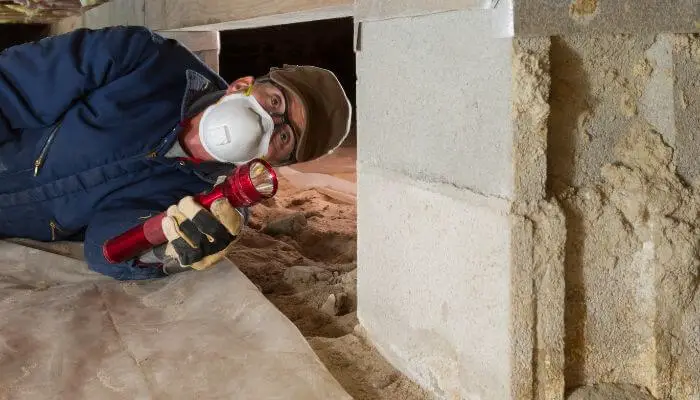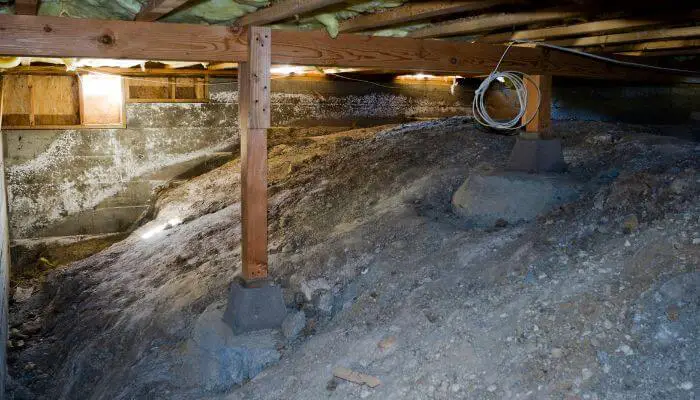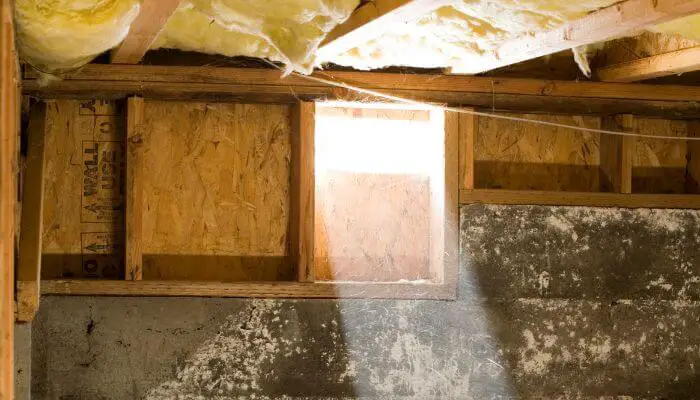Keeping your crawl space dry is important for preventing damp slowly damaging your home. Here are 7 methods you can use to ensure that it remains dry:
1. Insulate the Foundations
If you live in an area with extreme winter temperatures, insulating your walls and floors is an excellent idea.
An insulated crawl space will help manage moisture and prevent energy loss when keeping your home warm. It creates a thermal envelope to make that happen.

Here’s how you can insulate the foundations of the crawl space:
- First, assess the condition of your crawl space.
- Check for any presence of collected water and get rid of any moisture contained in the area.
- Insulate the walls of the crawl space using foam insulation boards.
- Attach these stiff foam insulation boards to the walls using latex adhesive or mechanical fasteners.
- Make sure to use accurately-sized sheet foams to reduce seams as much as possible.
- Seal off all the seams using PVC tape.
- You can also place an insulating mat on the floor of your crawl space for added coverage.
2. Use a Dehumidifier
Using a dehumidifier can keep moisture problems at bay. It’s a great way to control moisture and dry your crawl space.

Follow the steps below on how you can install a dehumidifier in the crawl space:
- Seal up the ground with a vapor barrier before installation.
- See to it that all the vents are closed off.
- Use a half-inch PVC pipe and connect it with the flex line using a cup link.
- The flex line is attached to the condensate pump that goes with the dehumidifier model.
- Run the PVC pipe to the foundation wall, then drop it outside below the dirt line.
- Run this pipe into a dry well full of gravel and cover it with dirt to conceal it.
- If you have a sump pump installed in your crawl space, you can run the line into the sump pump and have one discharge line from the sump pump.
To make your crawl space dehumidifier unit last longer, here are some helpful tips to keep in mind before installing it:
- Research the right kind of dehumidifier before buying one.
- Choose an energy-efficient model, preferably one which requires less maintenance.
- Pick the right spot to install your dehumidifier. (An ideal location would be where the dispensed airflow is not blocked and quickly drained.)
3. Fix Cracks and Holes
One way to prevent moisture buildup in the crawl space is to stop possible water entry points. Ensuring the crawl space is free from cracks and holes is essential to reach that goal.

Here are things you can do to manage crawl space cracks and holes:
- Inspect the walls and foundation of your crawl space to take note of cracks and holes where water can enter.
- Seal any wall cracks using epoxy injection.
- Another alternative would be to use carbon fiber strips to reinforce the cracked or bowed walls.
- Seal the cracks with a caulking gun.
4. Use A Sump Pump
It’s a real hassle to have flood water enter your crawl space. Imagine how much work it would be to remove all that unwanted water!
To prevent this, use a sump pump to discharge the water from the crawl space.
A sump pump works to detect increasing water levels and pressure in your crawl space. If the water level gets too high, it automatically pumps the excess water out of the crawl space through a discharge line.
5. Close Up Any Vents
Vents provide opportunities for moisture buildup. To avoid these, seal any vents or openings leading to your crawl space.

You can do this by using a vent cover, which you can find in the hardware store. If you can’t visit the store for any reason, use plywood and a caulk gun to seal off the vents. That should also work fine.
6. Move Downspouts to Prevent Backflow
Downspouts are necessary to drain rainwater from your roof, but they can direct water into your crawl space if not in a proper position.
Extending or diverting your downspouts is one solution to ensure that your crawl space doesn’t gather water. By doing so, the water won’t get near the foundation walls of your crawl space or seep through the openings.
You can do this by adding a downspout extension made from PVC or metal and positioning it to extend at least five feet away from your property.
7. Use A Vapor Barrier
A vapor barrier prevents moisture from dampening your crawl space’s flooring. This barrier comes in different sizes and thicknesses, so you’ll have to choose one that suits the moisture levels in your crawl space.

Here’s how you can install these heavy-duty vapor barriers:
- Place the vapor barriers over the floor of your crawl space.
- Seal any seams between separate vapor barriers.
- Finish by running the vapor barrier around twelve inches up the insulated walls.
- Tape the vapor barriers to the insulation using butyl tape.
Why Crawl Space Moisture Is A Problem
Crawl space moisture can be a troubling concern for any homeowner. It’s the basis for why you shouldn’t ignore the cause, as this will create many problems in the future.
Knowing why it should concern you as a homeowner would be helpful. Take a look at these moisture-related issues that can affect you and your family.
- Moisture buildup in your foundation walls can affect its integrity.
- Mold and dust as a result of a damp crawl space can cause allergies and other respiratory problems.
- Crawl space moisture can change indoor air quality by increasing your house’s humidity.
- It can leave a nasty smell drifting into your home.
- It becomes a breeding place for pests like cockroaches, rats, mice, and even termites.

